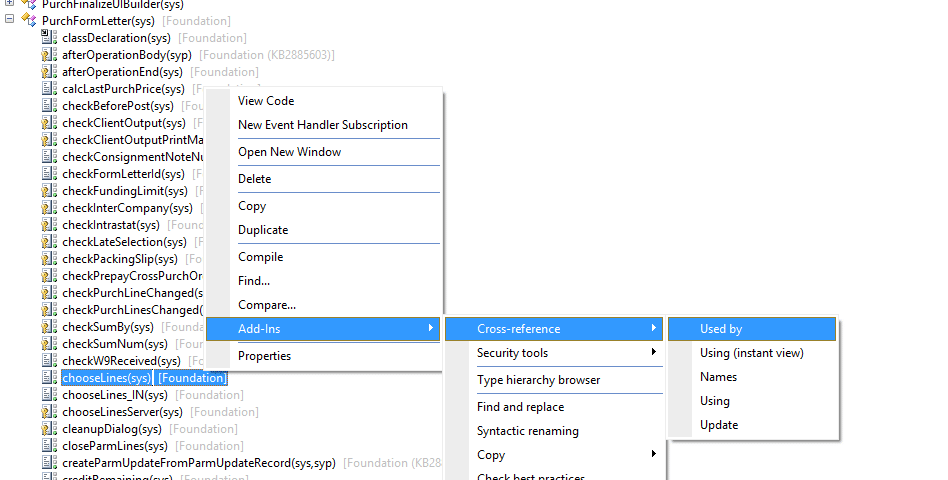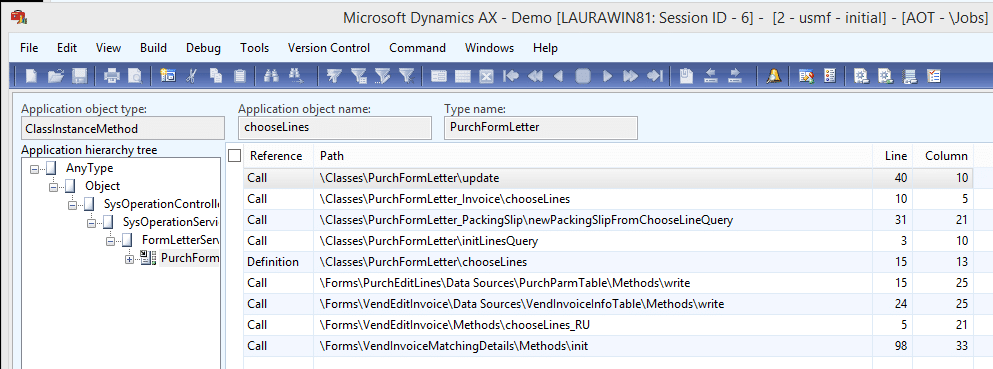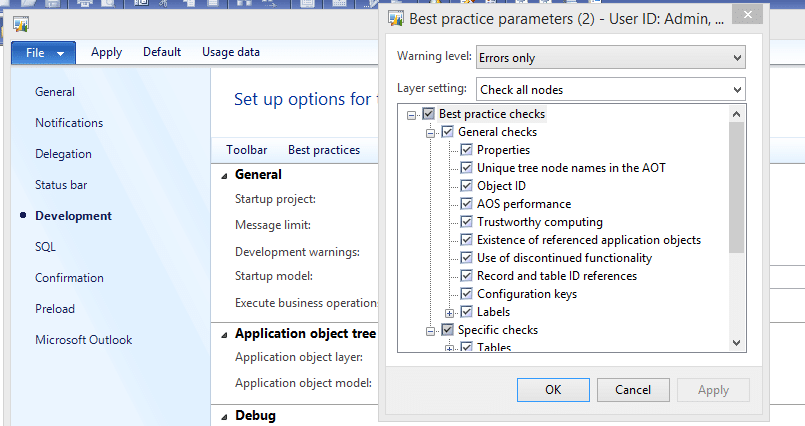AX Developer Tips for Newbies: Part 2
In a previous post I compiled a collection of tips gleaned from teaching AX developers in my training classes. The selections included in AX Developer Tips: Part 2 are dedicated to X++ coding tips.
Read more on AX Developer Tips for Newbies: Part I here.
Select statements
A. It is highly recommended to use a field list in your Select statements if you do not need access to all fields in the table. Just remember, only the fields in the list will contain values. If you try using another field later in your code, you will get unexpected results.
CustTable custTable;
select accountNum from custTable where custTable.AccountNum == 'US-001';
if (custTable.Blocked) //this will always be false because the field is null
{
}
B. Similarly, the exists/notexists join returns no data at all. In the following statement, the custInvoiceJour record buffer will contain no data.
CustTable custTable;
CustInvoiceJour custInvoiceJour;
CustTrans custTrans;
select custTable
exists join custInvoiceJour
where custInvoiceJour.OrderAccount == custTable.AccountNum;
For this reason, it is not possible to join another table using custInvoiceJour. This won’t work. The custTrans buffer will be empty.
CustTable custTable;
CustInvoiceJour custInvoiceJour;
CustTrans custTrans;
select custTable
exists join custInvoiceJour
join custTrans
where custInvoiceJour.OrderAccount == custTable.AccountNum
&& custTrans.Invoice == custInvoiceJour.InvoiceId
&& custTrans.AccountNum == custInvoiceJour.InvoiceAccount
&& custTrans.transDate == custInvoiceJour.InvoiceDate
&& custTrans.Voucher == custInvoiceJour.LedgerVoucher;
Where Clause and Indexes
When issuing select statements against tables in X++ code, align the where clauses in the X++ select statements to the fields that are contained within an existing index. If this is not possible, then consider adding an index to the table that matches the where clause. Where statements that do not align with indexes can cause table scans which lead to significant performance problems when the tables have a large number of records in them. This is especially true when selecting records from transactional tables.
Avoid statements like the following where the LedgerJournalTrans table does not have an index that contains the AcknowledgementDate in it.
LedgerJournalTrans ledgerJournalTrans;
while select ledgerJournalTrans where ledgerJournalTrans.AcknowledgementDate== today()
{
print ledgerJournalTrans.AmountMST;
}
FirstOnly
In select statements use the keyword firstonly to retrieve the first record found in the database table when verifying that a condition is true or false. For example when verifying if a given sales order contain any sales lines, firstonly can be used because once the first sales line is found the condition is true. Also use firstonly when the developer knows that only one record will be found in the table. By using the keyword the search through the database is completed as soon as the first record is identified.
Replace this code:
static CustTable find(CustAccount _custAccount, boolean _forUpdate = false)
{
CustTable custTable;
;
if (_custAccount)
{
custTable.selectForUpdate(_forUpdate);
select custTable
where custTable.AccountNum == _custAccount;
}
return custTable;
}
With:
static CustTable find(CustAccount _custAccount, boolean _forUpdate = false)
{
CustTable custTable;
;
if (_custAccount)
{
custTable.selectForUpdate(_forUpdate);
select firstonly custTable
where custTable.AccountNum == _custAccount;
}
return custTable;
}
Transactions and Locking
A. When there are ttsbegin and ttscommit statements nested within other ttsbegin and ttscommit statements, locks held on records in the table are not released until the outer ttscommit is reached, so keep the number of lines of code between the ttsbegin and ttscommit as small as possible. Additionally since the locks are not released until the ttscommit is reached avoid any tts statements that wrap dialogs requiring user intervention.
B. In the following code locks are initiated in both of the update statements. Those locks are not released until the final/outer ttscommit statement is reached:
CustTable ct;
SalesTable st;
ttsbegin;
while select forupdate Blocked from ct where ct.AccountNum == '1101'
{
ct.Blocked = CustVendorBlocked::All;
ct.update(); //lock obtained here
//do something
ttsbegin;
while select forupdate st where st.SalesId == "SO-101246"
{
st.CustAccount = "1101";
st.update(); //lock obtained here
}
ttscommit; //locks are not released here
print ct.Blocked;
}
ttscommit; // both locks are released here
Table Methods
Before writing a lot of code to access or update base tables in AX, take a look at the methods on the table you are interested in. Most tables in AX have built-in methods you can use to perform basic tasks like finding and initializing records.
Examples:
Find method – find a record by the primary key
static CustTable find(CustAccount _custAccount,
boolean _forUpdate = false)
{
CustTable custTable;
if (_custAccount)
{
if (_forUpdate)
{
custTable.selectForUpdate(_forUpdate);
}
select firstonly custTable
index hint AccountIdx
where custTable.AccountNum == _custAccount;
}
return custTable;
}
InitFrom methods -Initialize fields in the table from another table
public void initFromPostingProfile(CustPostingProfile _custPostingProfile)
{
CustLedger custLedger;
CustPostingProfile custPostingProfile = _custPostingProfile;
if (! custPostingProfile)
{
custPostingProfile = CustParameters::find().PostingProfile;
}
custLedger = CustLedger::find(custPostingProfile);
if (! custLedger)
{
throw error(strFmt("@SYS27773",custPostingProfile));
}
this.Settlement = custLedger.Settlement;
this.Interest = custLedger.Interest;
this.CollectionLetter = custLedger.CollectionLetter;
this.PostingProfileClose = custLedger.PostingProfileClose;
this.PostingProfile = custLedger.PostingProfile;
}
Cross-reference
Before anything else, do yourself a favor and update the AOT cross-reference in your development environment. The cross-reference system allows you to see the relationships between objects. It is most useful for finding where EDT’s, fields or methods are used in AX. When you are learning, it is an invaluable tool for quickly finding code examples in the base product and also ensures that you adhere to standard coding practices.
Yes, the update takes a long time to run. Try running it from a Job instead of from the Tools menu. Here is a sample job. Start it up at the end of your work day and it will be finished by the next morning.
static void CrossRefUpdate(Args _args)
{
xRefUpdateIL rbbTask = new xRefUpdateIL();;
rbbTask.setFullTree(true);
rbbTask.setSelective(false);
rbbTask.setUpdateTableRelation(true);
rbbTask.run();
}
Once the job is complete, you will have the Used By option as below:
We can find out how the ChooseLines method is used and from where:
Best Practices Compiler
Set the Compiler to Level 4 when you are writing new code. AX will point out Best Practice deviations at compile time.
Under Tools, Options, Development Tab, select Best Practices. Here you can set the checks that you want to perform.
Under the terms of this license, you are authorized to share and redistribute the content across various mediums, subject to adherence to the specified conditions: you must provide proper attribution to Stoneridge as the original creator in a manner that does not imply their endorsement of your use, the material is to be utilized solely for non-commercial purposes, and alterations, modifications, or derivative works based on the original material are strictly prohibited.
Responsibility rests with the licensee to ensure that their use of the material does not violate any other rights.




